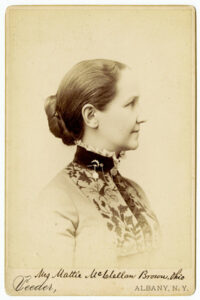Ohio Archives Month Spotlights: Wright State University Special Collections and Archives
by Collette N. McDonough, CA
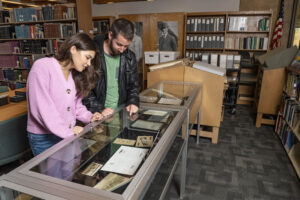
Research spaces at Special Collections and Archives in the Wright State University Libraries. Credit: Wright State University.
The Society of Ohio Archivists Advocacy and Outreach Committee is happy to announce that we will be spotlighting archives around the state again this year to celebrate archives month throughout October. Each of our archives spotlights will feature places that house materials related the theme of the poster, Land, Water, & Air: Transportation in Ohio.
The first archives we will be spotlighting in 2023 is Wright State University Special Collections and Archives. Even though Wright State’s submission was not featured on the poster this year, we are happy to have them front and center in our first archives spotlight.
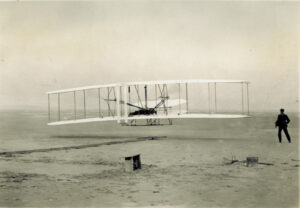
This famous image, taken by John T. Daniels, captures a moment of the twelve-second first flight. Daniels walked up from the U.S. Lifesaving Station at Kill Devil Hills to help the brothers. The Wright Brothers did not know if the image caught their airplane in flight until they developed the negatives at home back in Dayton, Ohio.
Wright State University was founded in the 1960s as a part of a plan to make higher education more convenient for Ohioans and got its start as a joint campus of the Ohio State University and Miami University. By 1967, the campus was granted independent status and named in honor of Dayton’s favorite sons, inventors of the manned heavier-than-air powered and controlled aircraft. The Wright State archive got its start with their first collection of Wright Brothers materials. In December 1975, the Wright Family “including Ivonette Wright Miller, Leontine Wright Jameson, Horace A. Wright, Milton Wright, Jr., and Wilkinson Wright,” gave materials to the archives to become the Wright Brothers Collection.
The archives are housed on the 4th floor of the Paul Laurence Dunbar Library named for the well-known African American author and Dayton native. The library is home to a “full-scale replica of the 1903 Wright Flyer suspended in the atrium. It was conceived and built by a dedicated group of volunteer model makers, mechanics, engineers, woodworkers, and seamstresses under the leadership of Howard R. DuFour.” The replica recently received a thorough cleaning by the facilities staff. Details are on their blog post, The 1903 Wright Flyer Replica Receives Cleaning!
The Reading Room has many items that any lover of aviation history would love to see such as medals the brothers were given in France or a propeller from a Wright Brother plane. If you want to visit the archives for research, you should make an appointment.
Wright State University Special Collections and Archives is home to a wide variety of transportation collections such as the Dayton Electric Railway Collection, the Canal Society of Ohio Collection and more. What they are really known for is their materials related to aviation and aerospace. A lesser-known collection is the Charles Wald Collection which documents the training of an early American aviator at the Wright School of aviation.
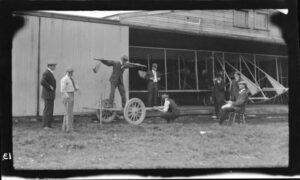
Harry Atwood practicing his balance on a cart. From left to right Henry Arnold, Arthur Welsh, Thomas DeWitt Milling, Orville Wright, Oscar Brindley and Calbraith Rodgers with the Wright Flyer B is parked in the hangar. Credit: Charles Wald.
Interview with Jane S. Wildermuth
Jane Wildermuth is the Head of Special Collections at Wright State University. She took some time to answer some questions about her job at Wright State for the Advocacy and Outreach Committee (A&O).
A&O: What do you like most about working at Wright State Special Collections?
Jane: What I enjoy most about working at Wright State Special Collections and Archives is being able to work with dedicated professionals who make my work life enjoyable and allow our department to accomplish much with a relatively small staff.
A&O: How does your current job compare to other archives positions you have held in the past?
Jane: I have enjoyed the various archival positions I have held throughout my career. I started at the Ohio History Connection and my positions were very focused as a reference archivist and then records manager. At Wright State, I have a wide variety of responsibilities from managing the department, writing metadata, answering reference requests, creating exhibits, and more.
A&O: What is the most interesting research question you have revived regarding transportation or the Wright Brothers?
Jane: We have a researcher who lives in California who is using CAD software to build 3D drawings of Curtiss-Wright engines and engine parts. Over the past several years we have sent him 1000s of drawings from our Curtiss-Wright Collection that he uses to make his designs. His work has given me a greater understanding of the collection which has allowed me to better assist other researchers.
A&O: What is your favorite collection that deals with transportation? Do you have a favorite image?
Jane: My favorite transportation collection is the Wright Brothers Collection. It is hard not to fall in love with the Wright Brothers if you work at Wright State. They truly were geniuses, and their innovative work continues to inspire people today.
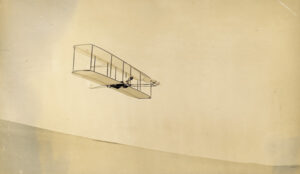
In 1902, Wilbur Wright pilots the glider while visiting Big Kill Devil Hill, North Carolina. Credit: Wright Brothers.
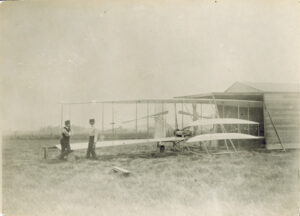
The Wright brothers at Huffman Prairie, near Dayton, OH, next to their 1904 Flyer. It was here where they learned the ins and outs of flying. Credit: Wright Brothers.
A&O: What is the most interesting story that the Wright State archives hold that does not relate to transportation?
Jane: I am fascinated with the story of Martha McClellan Brown.
She was born in Maryland in 1838, but her family later moved to Cambridge, Ohio. She married William Kennedy Brown, a Methodist Episcopal minister, at age 20. The couple shared an interest in advocating for women’s rights, suffrage, and social reform. They became greatly involved in the temperance movement in Ohio and nationally. Brown served as the Grand Chief Templar of Ohio and was a popular speaker throughout the country. She drafted the Plan of Work and the call for a temperance convention that took place in Cleveland in November 1874. At that convention, the Women’s Christian Temperance Union was founded. Brown went on to take leadership roles, including vice president, in the Prohibition Party. She later worked in academia as a professor and vice president of the Wesleyan Female College in Cincinnati.
Follow the Wright State University Libraries’ Special Collection and Archives on social media:
X: @WrightStArchive
Facebook: @wrightstatearchives
Instagram: @wrightstarchives
All images courtesy of the Wright State University Libraries’ Special Collections and Archives.
Last Updated on October 24, 2023 by Emily Gainer


